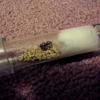Anyway, we have ordered him a small formicarium that has some holes to be expanded. It will arrive next week, but now we need to figure out what to keep in it. I’ve put out some feelers at different places (including here a little) to get a colony, but I’m not really sure what species I should be aiming for. I’m just barely educated enough to know that the parasitic ants are usually not a good starter ant and I won’t have termites* in my house. That only leaves, what, around 8,000 species of ants?
I forgot to mention that I’m also aware that it is best to only keep ant species native to one’s area (New Jersey in my case). Finding a complete-ish list for NJ has been harder than I thought and even then I don’t really know what I am looking at. So I’d love some help. Any feedback would be welcome!
*-apologies to board termite keepers but you all must live in cement boxes in order to sleep at night.



















